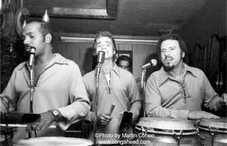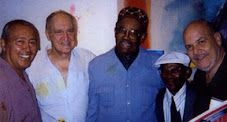 Singers want to be actors and actors want to be dancers, but none of them want to be prize fighter. But prize fighters make good dancers. With their speed, balance, endurance and courage, they are unequaled in performance before the public. Millions of dollars are paid to witness them in action and millions are wagered on the outcomes.
Singers want to be actors and actors want to be dancers, but none of them want to be prize fighter. But prize fighters make good dancers. With their speed, balance, endurance and courage, they are unequaled in performance before the public. Millions of dollars are paid to witness them in action and millions are wagered on the outcomes.I was taught to dance by a prize fighter named Nino “The Great” Yacavino, but also how to be my best in managing my life with an emphasis on performance.
We were always attracted to prize fighters while growing up. All I had to do was look out my bedroom window to watch matches presented by the Bay Ridge Boxing Association, with the ring set up on the tennis court grounds that in the winter were used as a skating rink. I had a free ringside set to watch graceful boxers, ice skaters and tennis players.
My mother, who used to dance in her red dress on the top of a table at family gatherings, was a fight fan who in summer vacationed at Tony Cammonari’s training camp in the Catskills, and who took me to see Prima Carnera on stage at Loew’s Sheridan in the Village, where we lived while growing up. My dad, on the other hand, was less interested in pugilism and the fight crowd. Mom was a tough cookie, a fighter who beat the Great Depression.
Nino Yacavino was a Brooklyn fighter who wanted something better for himself than a brutal beating. He and his wife and sister-in-law organized a dance troupe that included a Latin dance teacher and his partner, and needed only one other member for his tall sister-in-law. My height got me the job, not my dancing ability, since I couldn’t even do the fox trot and had difficulty finding patent leather shoes to fit me. What I did have was a familiarity with Latin music and the rhythms of the 1938 Casino de la Playa orchestra from Havana.
Being tall for my age at 18, I tended to slouch so that when Nino contacted me, the first thing he did was teach me how to walk across the room balancing a book on my head. Since his nightclub date was fast approaching, he and his wife soon had me doing the box step and learning our routines, which included rumba, bolero and samba. To learn more, I went to the Park Plaza, where the best Latin dance team in America, Rene and Estela, taught me more basic movements so that a dancer was born!
During the ‘30s, the boxing profession was Mafia, as was horseracing and many of the nightclubs with “cut liquor,” betting parlors and gambling rooms. Nino may or may not have been involved with the Mafia but he did succeed where others failed by getting us a full summer’s gig at the Rumba Casino in West End, Long Branch, New Jersey. The place was perhaps a gambling joint but well concealed from us. It was owned by Jimmy Pellechia, boxing commissioner of New Jersey, who later served time for mortgage fraud (see the Daily News, 1938). When the club signed up a troupe called the China de Simone Dancers, there was among the girls Gloria Cook, an ex-mistress of Al Jolson with whom I did a duo act with fast rumba and lifts. When Jimmy Pellechia fell in love with my partner Gloria, he gallantly offered me a dance studio in the solarium of the Kingsley Arms Hotel in Asbury Park, which he owned. Food and board were on him for the balance of the summer season on the Jersey shore, since he broke up my act by taking Gloria to Hawaii.
Then, back in New York City, I teamed up with a dance student at Davalos Dance Studio on Broadway and 50th Street, and found myself in a Latin troupe formed by Davalos, for a performance at the Beacon Theater upstate in Beacon, New York. This led to my hanging around the Cuban Village at New York’s 1939 World’s Fair, as an understudy for the troupe that had been hired there. Whenever free, I frequented all the Latin dance spots around town: the Audubon Ballroom, the Park Plaza, the Masonic Lodge on 106th Street, the Caborojeno Workers Circle, Ben Mardes’ Riviera Club, and the more elegant nightspots such as Havana-Madrid, Versailles, Martinique and Embassy, until I was called to join Bob Conrad’s La Playa Dancers, booked into the Wonder Bar in Detroit in winter, 1939. Xavier Cugat was playing at the Statler Hotel there at the time.
My next gig was to be at the Carrousel Club in Miami, where I opened two dance studios at the new National Hotel and the Royal York in 1940, as well as at the exclusive Tatum Surf Club. While attending the University of Miami, I was working nights at the Coral Gables Country Club. It was in 1940 that I first visited Havana for a weekend, then again to attend the University of Havana in 1941 [see the blog entry “An Afro-Cuban Blessing”].
While in the military during the war, I performed Latin dance for US troops in the Philippines, then returned to the US to teach Latin at Grossinger’s Hotel with the Tony and Lucille Colon Dance Studio, along with Mike Terrace and Johnny Lucchese. In 1948, I began a long career on cruise ships as cruise director. Wherever travel took me, I spoke, danced and taught conga, bolero, rumba (fast and slow), plus the beguine and the merengue, samba, tango, pachanga, mambo (“Mambo #5” was a nation-wide hit and made Perez Prado famous) and the Mexican waltz—but still stumbled over a fox trot!
Prize fights and nightclubs during the early 1940s were gang-controlled turf that exposed me to people such as Santo Trafficante in Cuba, who invited me to be a “shill” with the tourists I escorted. I asked Bugsy Siegel for permission to dance with Virginia Hill, his gal, at the Beachcomber in Miami Beach. I asked Skinny D’Amato if he knew Jimmy Pellechia, the ex-boxing commissioner of New Jersey, jailed for fraud. The Musicians Union boss Petrillo may not have been “mob,” but I shook his pinky as he demanded.
My second nightclub gig was at the Carrousel Club in 1941. It was bankrolled with some of the money belonging to champion fighter Lou Tendler from Philadelphia. The Wonder Bar in Detroit, a city riddled with unemployed ex-Prohibition mobsters, was “mob,” as was the gambling joint called Club Bali in Miami, where I lost my paycheck every week. The 1939 Rhumba Casino, as we’ve seen, was Jimmy Pellechia’s, whose mob ties and gambling debts put him behind bars.
At the MGM, Las Vegas, in 1976, I ran into a friend, Wingy Gruber, the one-armed greeter from my old Club Bali days, not to mention from the crowds at the Tropicana in Havana. In the ‘70s, the cruise industry became big-time casino business, and I quit just as I could have made my knowledge pay off. Perhaps the African gods, the orishas, were talking to me about justice and the little man.
Fighters make good dancers, but dancers don’t make good fighters, as the following incident explains. One night at the Rhumba Casino, Nino Yacavino suffered a sudden appendicitis attack. He was throwing up bile and perspiring profusely. He pushed us away when we tried to restrain him from going out on the floor to perform. Coming off stage, he went to the hospital, semiconscious.
This was something Nino couldn’t teach me: how to be a true trouper, an average fighter who gets up off the floor to be a prize fighter, like my mom—who I taught to dance the mambo.


No comments:
Post a Comment